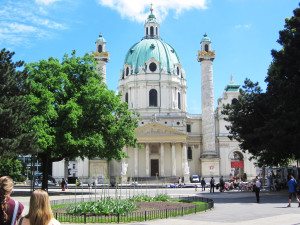From March 16-30 of 2016 a group of 15-18 students will travel to Vienna, one of the Western world’s oldest and most historically influential cities. Dr. Peter Meilaender, who has traveled to Vienna several times and speaks fluent German, stated that he is excited to lead students through the Innenstadt (the oldest and most central part of Vienna which was once occupied by the Roman Empire). He said, “The old part of the city is really very compact, so you could walk across it on foot in under an hour. Around every corner there’s some new, remarkable building…there are churches everywhere.” The compact nature of the central city will provide a good opportunity to see its most crucial landmarks within a relatively constricted amount of time.
 The timeframe of the trip will allow students to experience Vienna during one of its most significant festivals: Holy Week, leading up to Easter Sunday. The vast number of Baroque churches will be filled with thousands of people celebrating the Resurrection, which will provide insight into the importance that many European cities still place on these religious holidays. Dr. Meilaender stated, “A high Catholic mass in a great cathedral on a major festival is an experience not to be missed.”
The timeframe of the trip will allow students to experience Vienna during one of its most significant festivals: Holy Week, leading up to Easter Sunday. The vast number of Baroque churches will be filled with thousands of people celebrating the Resurrection, which will provide insight into the importance that many European cities still place on these religious holidays. Dr. Meilaender stated, “A high Catholic mass in a great cathedral on a major festival is an experience not to be missed.”
Students will certainly be getting a great deal out of the two credits which the course requires. In addition to staying in one of the West’s most beautiful cities for two weeks, students will be studying the art, history, literature, and architecture which make Vienna so unique. The crux of the course will focus on the period leading up to World War One, which was extremely tumultuous for all of Europe. However, Dr. Meilaender said that out of this culture breakdown arose an “outburst in creativity” which accounts for much of the artistic traditions that came from Vienna during this time. Artists such as Gustav Klimt, most famous for his painting “The Kiss,” lived and worked in the city during the early 1900s, and are upheld as the originators of the modern style of art.
While in Vienna, students will be expected to attend class for three hours in the morning after which they will be free to roam the city for as long as they like. Vienna has a wide variety of coffee shops, museums, and churches, all of which are world renowned. Navigating the city should not prove too difficult because of its compactness and communicating with the locals should be equally promising as many people speak English. Dr. Meilaender said, “You can just wander around and constantly see amazing things, more than we could possibly fit into two weeks.” Perhaps, then, this Spring’s trip to Vienna will lead to a love for the city which will bring students back again.
